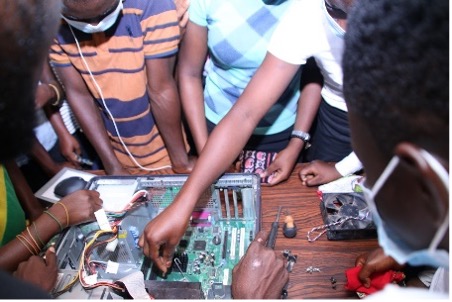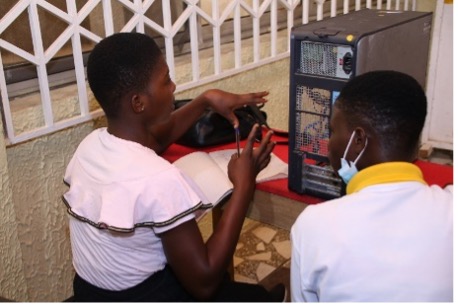For decades, international agencies such as the U.N. have stressed the urgency and necessity of gender digital equality, yet in low- and middle-income countries like Ghana, progress has been frustratingly slow. Researchers at the UW Information School’s Technology and Social Change Group (TASCHA) want to know why.
In partnership with Ghana-based researchers Kwasi Ansu-Kyeremeh, Marcia Abonie and Naa Ansaa Ansai-Koi from the MmaaTech Foundation, Maria Garrido and Araba Sey investigated the extent to which family norms, classroom dynamics and policymaking — which we can think of as separate, yet intersecting ecosystems — support or hinder young women’s aspirations and opportunities to engage with digital technology in their personal lives and pursue STEM-related professions.

Building upon MmaaTech’s ongoing initiative that provides apprenticeship programs to train young women for careers in traditionally male-dominated fields, the study involved 15 young women and 7 young men from a rural community in Atwima Apemanim, in the Ashanti region of Ghana. Researchers asked the participants to journal about their daily activities and then conducted focus group discussions with families and educators and interviews with policymakers. Finally, the participants engaged in a 6-day training program that taught them a range of skills such as typing, Microsoft Office and HTML.
“The opportunity to touch and navigate a computer for the first time was a surreal experience for the girls,” said Marcia Abonie, a research fellow at MmaaTech Foundation. “The young women have moved from inability to type on the computer to basic skills in coding.”
The study led the research team to discover some surprising disconnects between professed values and reality. Parents, teachers and policymakers all understand that accessing and using information and communications technology (ICT) is necessary for young women’s self-efficacy and economic empowerment, yet in each ecosystem, barriers persist.
These disconnects, researchers believe, create a self-fulfilling prophecy that prevents young women from having the confidence to engage with technology: Parents and teachers assume young girls aren’t interested or capable, so young girls have little to no opportunity to access technology. Because of this, they have little experience or skills and therefore lack the confidence to seek it out in their personal lives or in classrooms. But researchers also found that certain interventions can work.
“The exposure and experience of the training have empowered the young women,” Abonie said. “They now consider ICT-related careers as possible future careers.”
The interventions that TASCHA research scientists Garrido and Sey, along with Ansu-Kyeremeh and Abonie, designed in Ghana respond to a larger phenomenon. Despite years of rhetoric and policies, women remain significantly underrepresented in STEM education and in STEM-related occupations all over the world. The latest available statistics from UNESCO (2019) show that women are about 30% of the STEM student body in higher education, 25% of the STEM labor force, and only 28% of the world’s researchers.
Where gender inequality persists
The persisting gender inequality in technology access and STEM education is concerning given the long history of international development agendas that explicitly articulate gender equity goals. Among them is Sustainable Development Goal 5 of the U.N. 2030 Agenda, which was adopted in 2015 and sets specific targets for improving women’s and girls’ technology access and education. And although some progress has been made, it is important to avoid a misplaced sense of accomplishment over such policies to advance gender digital equity. On the surface, for example, the gender digital gap seems to be narrow. According to ITU, an average of 69% of men and 63% of women worldwide were online as of 2022. This, however, translates to 259 million fewer women using the internet than men.
Furthermore, that gap has been virtually eliminated in the developed world, with 89% of men and 88% of women online. Most Latin American countries have closed the gender digital gap, too. This means the women and young women of least developed countries and Landlocked Developing Countries, especially in Africa, are shouldering the burden of technology access inequality. They face poverty and poor formal education, and they lack access to electricity and basic health care. They also lack the skills and awareness to use or work in technology. In these places, roughly 4 out of every 5 women are still offline.

According to Sey, the research methods they employed in Ghana helped “uncover how unacknowledged misalignments within and between household, educational and policy contexts may explain the persistence of gender inequality in ICT skills.”
For example, Ghanaian national agendas to advance digital development and gender equity are disconnected from the lived experience of young women, especially young women in rural communities like Atwima Apemanim. Women who live in rural areas and those near and around cities face scarce resources, inadequate infrastructure, and persistent gender bias, yet national policies, which are drawn from international organizations and agendas, are disconnected from these conditions. Furthermore, government programs to address inequities in technology access and education are not evidence-based since most of the limited national statistical data is not broken down by gender.
Focus group discussions with parents revealed another important disconnect: Though parents believe it’s important for all children to learn and use technology, their male children have more time and freedom to access technology than their female children. Not only are female children expected to do more chores, which must be prioritized over their time with technology, parents are more protective of them and fear their potential exposure to harmful influences while online.
Teachers also assume young men are more naturally capable, intuitive and adventurous, and they therefore disproportionately allocate the already limited technology resources available. Young women who are enrolled in ICT classes have fewer opportunities to touch a keyboard, likely due to implicit biases and assumptions about their abilities. They also don’t see themselves in their role models — almost all ICT teachers, tutors and professionals are male. And yet, as with parents, teachers profess the belief that ICT education is important for all children.
These disconnects create environments that inhibit young women’s aspirations and capabilities to engage with technology as consumers, creators and professionals.
Training sessions show promise
So, what interventions will help align rhetoric and values with the lived experiences of young women in places like rural Ghana? Researchers found that even a short, 6-day training session, designed with different assumptions about young women’s aptitude for learning technology and facilitated by female and male ICT professionals, created the environment for young women to start building meaningful skills. The trainees participated in a hands-on, collaborative learning environment, which improved their confidence and expanded their aspirations for learning technology. Trainees who entered the program, for example, reported that they hoped to learn typing skills, yet when they left the program, they did so with hopes of repairing computers and learning advanced software.
Reflecting on her training, one participant, age 14, said, “I am very happy with what I learned during this training. I am not afraid of working with the computer and I can use it now to submit my work in school, teach my younger siblings so they also have more opportunities in life, and search and learn about things from over the world.”

Parents and families also saw positive impacts from the training. “During our focus group discussions, some parents reported that after their daughters took part in MmaaTech training, they became more enthusiastic about continuing to support their daughters’ technology education,” said Garrido. “Plus, it was a delight for them to see their daughters teaching their siblings and, in some cases, even aiding their parents with technology.”
In their forthcoming report, the researchers make a set of recommendations for how to start correcting misalignments and disconnects more broadly. Among them: The education system needs more resources to adequately recruit and compensate ICT teachers. Teachers then need more resources to motivate and prepare all students, including young women, for national science, math, and ICT tests. These investments, in addition to effective social programs developed by the government, can help reshape both the perception of young women’s ICT aptitude in the classroom and social dynamics at home. Such programs need to accurately reflect data on women’s and young women’s access and use of technology, and currently, this data isn’t readily available.
The most promising way forward, according to Ansu-Kyeremeh, is “data-rich policy that clearly sets boundaries and directives with mechanisms to effectively monitor the results of programs and projects.”
The recommendations are timely in light of the 2023 U.N. Commission for the Status of Women, which takes place in March. This year’s main themes center on technology, education, and empowering women and young women from rural communities.
This story was originally published on the TASCHA website.